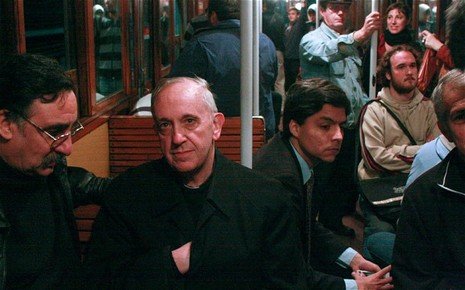The Marian Church of Pope Francis
 It seems that Pope Francis lives in a more personal, compassionate and collegial Church, rather than in a legalistic, hierarchical and ritualistic Church. He does not refer to himself as Pope so much as Bishop of Rome, he prefers to live in community rather than alone in the papal apartment, he dreams of a poor church for the poor, he spurns the trappings of ritual and power, he celebrates Mass with a community rather than in private. This could be described as a Marian Church, the Church of Pentecost, a Church of a community guided by charism rather than by law.
It seems that Pope Francis lives in a more personal, compassionate and collegial Church, rather than in a legalistic, hierarchical and ritualistic Church. He does not refer to himself as Pope so much as Bishop of Rome, he prefers to live in community rather than alone in the papal apartment, he dreams of a poor church for the poor, he spurns the trappings of ritual and power, he celebrates Mass with a community rather than in private. This could be described as a Marian Church, the Church of Pentecost, a Church of a community guided by charism rather than by law.
In the Catechism of the Catholic Church, at #773, it is taught that ‘the “Marian” dimension of the Church precedes the “Petrine”.’ The supporting reference for this statement is to John Paul II’s 1988 apostolic letter on the dignity and vocation of women, Mulieris Dignitatem #27.In that paragraph John Paul II writes not so much about precedence as about the Church being ‘both “Marian” and “Apostolic-Petrine”. However, as Brendan Leahy notes in his contribution to The Legacy of John Paul II, John Paul II stressed the priority of the Marian in an address to the Roman Curia before Christmas 1987:
This Marian profile is also – even perhaps more so – fundamental and characteristic for the Church as is the apostolic and Petrine profile to which it is profoundly united…. The Church lives on this authentic ‘Marian profile’, the ‘Marian dimension’…. The Marian dimension of the Church is antecedent to that of the Petrine…. Mary … precedes all others, including obviously Peter himself and the Apostles….
Leahy then shows how the theologian Hans Urs von Balthasar influenced both John Paul II and Benedict XVI in their view of “the Church’s charism-institution polarity within the interplay between the Marian-Petrine profiles”.
In his essay on ‘Von Balthasar and the Office of Peter in the Church’, John McDade explains that for von Balthasar:
Mary is at the centre of the Church because her faith represents ‘the all-inclusive, protective and directive form of all ecclesial life’, ‘the model of all being and acting’ in the Church…. ‘The entire Church is Marian’, von Balthasar says … because ‘Mary disappears into the heart of the Church to remain there as a real presence which, however, always gives place to her Son’. For von Balthasar, the radiant heart of the Church is lay, faithful and holy….
By displacing the Petrine office from the ‘centre’ or ‘top’ of the Church, von Balthasar aims to restore an ecclesiological balance which an over-juridical, ultramontane approach to papal authority has disturbed…. He argues that one nourishes the other—the Church is both Marian and Petrine—and that they are not to be opposed….
While the Marian Church of von Balthasar, John Paul II and Benedict XVI is described in abstract principles, Pope Francis stresses the Marian dimension to the Church in uncompromising practical ways.
For example, in his address to the Italian Bishops on 23 May 2013, his closing prayer included not only addressing Mary at the heart of the Church, but also the practical implications of being a tender and compassionate Church on pilgrimage, rather than a more hierarchical institution: ‘being pastors also means to be ready to walk in the midst of and behind the flock: capable of listening to the silent story of the suffering and bearing up the steps of those who are afraid of not succeeding; careful to raise up, to reassure, and inspire hope’. And so he prayed:
Mother of the silence that preserves the mystery of God …
Purify the eyes of pastors with the balm of memory: that we might return to the freshness of the beginning, for a praying and penitent Church….
Cloak Pastors with that compassion that unifies and integrates: that we might discover the joy of a humble and fraternal servant Church…. Mother, we will be the People of God, on pilgrimage towards the Kingdom. Amen.
It seems that in Pope Francis’s practice, the “Marian” dimension of the Church actually does precede the “Petrine”.
From UCAN Spirituality Special Features


 Votes : 0
Votes : 0









